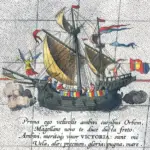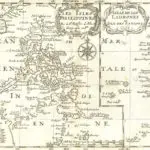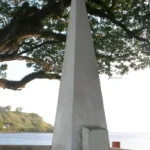Ferdinand Magellan




Table of Contents
Share This
Guam's first European contact
Ferdinand Magellan (1480 – 1521), born in Portugal and killed in Cebu, Philippines, was a Portuguese seafarer and navigator who worked most of his life for Castille, the Spanish throne. In 1520-1521, Magellan commanded an expedition of five ships whose mission was to find a passage around the American continent to the Spice Islands (Moluku, Indonesia). At the tip of South America, he discovered the strait that now bears his name, but after reaching Asia he was killed in the Philippines. Only one of the remaining two ships with 18 survivors of the expedition returned to Spain, completing the first circumnavigation of the earth.
Magellan began his life as a seafarer in his native country, Portugal, at the age of 25 when he was sent to India on an expedition to secure Francisco de Almeida as viceroy of the Portuguese territories there. A year later, in 1506, he sailed to the Moluku Islands, Indonesia, where he bought a slave named Enrique or Enriquillo, who accompanied Magellan on all future voyages. In 1513 Magellan was injured during combat in northern Africa, and since then he suffered with a limp.
Magellan fell out of favor with the Portugese Court after taking leave without permission and was accused of trading illegally with the Moors (Muslims). He knew Spain was looking for a route towards the Spice Islands without crossing the Portuguese area of the world established by the Treaty of Tordesillas, Magellan presented a plan of expedition to Charles V of Spain. The expedition departed from Sanlúcar de Barrameda in Spain on 20 September 1519, with five ships: the flagship Trinidad together with the Victoria, Santiago, San Antonio and Concepcion. On board were approximately 270 men with a wide range of nationalities, including Antonio de Pigafetta, an Italian nobleman who was anxious to take part and chronicle the journey.
Expedition accounts and naming of Ladrones
The chronicle written by Pigafetta is therefore the first known written account of contact between ancient CHamorus and Europeans. This account is the most detailed found today, both in general information about the voyage and in relation to his description of the “Islands of Thieves” or Islas de Los Ladrones, which Magellan named the archipelago after a misunderstanding about property rights. The archipelago was initially named the “Island of Lateen Sails” or Islas de las Velas Latinas as the explorers were amazed by the swiftness, agility and how the CHamorus easily maneuvered the proas which greeted them as they approached the islands.
In addition to Pigafetta’s accounts, there are seven other manuscripts, of the 11 (chronicled by different authors of the expedition) that allegedly once existed, that describe or mention the events of the voyage and the arrival in the Marianas.
According to Pigafetta, the travelers sighted three islands of the Marianas archipelago on 6 March 1521 (or 17 March, according to Ginés de Mafra, another chronicler of the same expedition). The crews were on the verge of starvation. Navarro, the sailor who first sighted land, was rewarded with gold jewelry worth more than 100 ducats for his good eye.
Perceived theft
De Mafra mentions that the first incident between CHamorus and Europeans took place when an officer of the Trinidad “for little cause” slapped one of the islanders, who then slapped him back. The officer returned with a blow of his machete, at which the islanders jumped into the water, returned rapidly to their proas and started to throw spears at the ship, hurting some of the Europeans.
Another group of CHamorus came from shore and went over to the ships and started trading while the first group continued throwing spears. After the trading was concluded, and to the surprise of the Europeans, the second group of CHamorus joined the group that was fighting. Seeing that the number of canoes was increasing, Magellan ordered his crew to stop fighting, after which peace was re-established, and commerce and trade was resumed.
Some islanders cut the rope of one of the skiffs off the Trinidad and took it. Magellan arranged a punishment for this perceived theft, disembarking the next day and setting some settlements on the coast on fire. Seven CHamorus were killed during the attack. Following an old medieval superstition, the European sailors who were sick asked crew members, who took part in the attack, to bring back the entrails of the dead natives, so that they could eat them and recover their health.
Historic significance
Pigafetta was among the landing party, so in his chronicle he described for the first time some of the customs of the ancient CHamorus and the extraordinary mastery they had over their proas.
The identification of the exact place of Magellan’s landing in the Marianas continues to generate great scholarly debate. Three islands were spotted from the ships, two of them close to each other and the third, a bigger island, off to the north. Although in Guam a tradition refers to the bay of Humåtak as the landing site, the logic of the route that the expedition had taken, together with the contradictory testimonies of the surviving accounts, suggests that the site was somewhere to the north of Humåtak or even north of Guam itself, possibly on the island of Saipan. It may be logical to suppose that the oral tradition referring to Humåtak as a landing site refers to the expedition of Legazpi, who in 1565 disembarked there as many others did over the years.
After two days in the “Ladrones” or “Islands of Thieves” as they were named by Magellan, the fleet continued its route towards the West. Not long after his visit to the Marianas, Magellan would die in combat in the island of Mactan in Cebu, after taking sides in a local struggle between two chiefs. The Trinidad continued onward back to Spain under the command of Juan Sebastián Elcano. Only 18 survivors of the original crew arrived once again in Sanlúcar de Barrameda on 6 September 1522.
In many ways, Fernando de Magellan represents a turning point in the history of Guam. His voyage heralded the beginning of a series of intermittent visits to the Marianas, throughout the next 150 years, by foreign navigators. For the indigenous population, these trips represented a series of contacts, often saturated with violence, problems of communication and trickery – as well as the exchange of objects of value. On some occasions, islanders were kidnapped, to be used as guides or as protégés of missionaries.
For the Europeans, the incorporation of news about the existence of an inhabited archipelago with resources for supplying ships and crews marked a milestone in the cartography of the Pacific Ocean, whose vastness was practically unknown until then. In the maps of the 16th century, the “Islands of Thieves” represented the first geographical reference to new lands in the Pacific.
For further reading
de Elcano, Juan Sebastián. La Primera Vuelta al Mundo. Madrid: Miraguano Ediciones, 2003.
Pigafetta, Antonio. Magellan’s Voyage: A Narrative Account of the First Circumnavigation. Vols. 1-2. New Haven: Yale University Press, 1969.
Rogers, Robert. Destiny’s Landfall: A History of Guam. Honolulu: University of Hawai’i Press, 1995.
